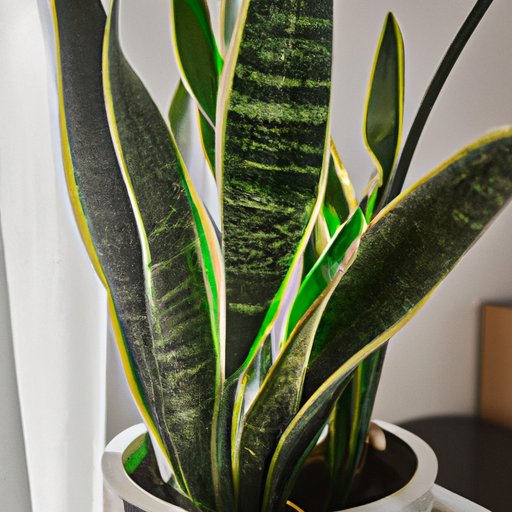
Introduction
Snake plants, also known as Sansevieria, are a popular houseplant due to their low maintenance and air purifying properties. However, like any plant, they still require care to thrive. This article will cover everything you need to know about caring for your snake plant, from choosing the right one to styling it in your home.
Writing a Beginner’s Guide
If you’re new to caring for plants, snake plants are a perfect starter option. These tall, sleek plants are known for their stiff, upright leaves and are native to Africa and Madagascar. Here are some tips for choosing the right one and keeping it healthy:
Choosing the Right Snake Plant
When selecting a snake plant, look for one with firm, green leaves. Avoid plants with brown tips or soft, mushy leaves, which could indicate overwatering or an unhealthy plant. You can also choose to purchase a small snake plant or propagate a larger one by separating the root-ball and planting in a new pot.
Where to Keep Your Snake Plant
Snake plants can thrive in a variety of lighting conditions but prefer indirect natural light. They are adaptable to a range of temperatures but avoid placing them near drafty windows or doors.
Watering Needs, Soil, and Repotting
Snake plants are known for their resilience to neglect and prefer drier soil to overly moist soil. Water your snake plant once every 1-2 weeks, ensuring the soil is dry before watering again. When repotting, use well-draining soil and avoid planting in a container that is too large for the plant.
Top Benefits You Gain from Having a Snake Plant
Along with being a low maintenance plant, snake plants provide many benefits to your home:
Air Purifying Properties
Snake plants filter toxins such as formaldehyde and benzene from the air. This makes them a great addition to your home office or bedroom for a cleaner, more refreshing atmosphere.
Low Maintenance Requirements
Snake plants require little attention, making them an ideal houseplant for busy individuals or those who want to start with an easy-to-care-for plant.
Aesthetically Pleasing and Versatile Decor Option
With their tall, slim silhouette and differing leaf patterns, snake plants can complement a variety of home decor styles. They can be placed on the floor, on a ledge, or on a table, and their modern look can elevate any room.
Tips and Recommendations for Keeping Snake Plants Thriving
For healthy snake plants, avoid overwatering and ensure they receive adequate sunlight. You can also mist your plant to promote healthy leaves and root growth. Additionally, avoid placing your plant in a location with temperature changes, such as near heating or cooling vents.
Seasonal Care
As with any plant, seasonal changes can affect your snake plant’s health. Here are some tips and tricks for adapting care according to seasonal changes:
Differences in Care Routines for Spring, Summer, Fall, and Winter
In the spring and summer, snake plants should be watered more frequently to accommodate for the warmer weather. During the fall and winter, reduce watering to avoid over-watering and make sure the plant is not in a drafty location.
Tips and Tricks for Adapting Care According to Seasonal Changes
Regularly checking the soil and adjusting watering schedules according to seasonal changes is key to maintaining a healthy snake plant year-round.
Common Problems and Troubleshooting
Even the easiest plants to care for can encounter problems. Here are some common issues snake plant owners may experience and solutions to these problems:
Identification of Problems such as Pests, Overwatering, and Inadequate Sunlight
Common issues with snake plants include spider mites, over-watering, lack of drainage, or inadequate sunlight. These issues can be addressed by ensuring the plant is in well-draining soil, not over-watered, and in a location with adequate light.
Solutions to Common Problems
To treat spider mites, use an insecticidal soap and make sure to regularly mist the leaves to keep them healthy. For over-watering, make sure there is adequate drainage and cut back on watering intervals. Lack of sunlight can be addressed by moving the plant to a sunnier location or utilizing grow lights.
Showcasing Unique Ways to Style Snake Plants
Snake plants’ sleek aesthetic makes them a popular choice for modern decor, and there are many unique ways to incorporate them into your home:
Creative Potting Ideas
Snake plants can be potted in a variety of containers, including woven baskets, concrete planters, or colorful ceramic pots. Use different materials and textures to add interest to your plant’s display.
Incorporating Lighting and Other Design Elements
Adding lighting elements, such as string lights or floor lamps, can make your snake plant an eye-catching focal point in any room. Additionally, you can pair snake plants with other trendy indoor plants such as fiddle leaf figs or monstera leaves.
Benefits of Enhancing Decor with Snake Plants
Snake plants can add character and personality to your home, filling voids and adding an additional level of design. They’re known for being a versatile plant with many different looks, meaning there is a variety of unique styles you can add to the decor in your home.
Conclusion
Overall, snake plants are an excellent choice for beginner gardeners and plant lovers alike. They provide many benefits to your home, are easy to maintain, and can be styled in a variety of unique ways.





